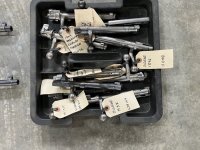KePet - I am not sure that the number on the bolt has to match the serial number on the receiver - often they do, but I do not think they HAVE to - I just finished assembling a Mauser 98 in 7x57 for myself - so a German (?) surplus receiver, a random bolt bought somewhere because of the sporterized bolt handle and a barrel marked "Alpine Co.", which I think was a British Company. The stock is an elder Ramline synthetic (I do not think that brand exists any more?) The front banded sight is home made by someone in Quebec. The rear sight is a Parker Hale Sportarget sight that has been welded or brazed to a military Mauser 98 cocking piece - so that cocking piece, the bolt shroud and the firing pin and its spring are not original to that bolt. The trigger and sear are not original to that receiver, but now work fine. The bolt lugs now do bear correctly in their seats in the receiver - they did not when I started, but they are lapped in now. The bolt is now timed to the receiver - metal to metal contact when bolt is closed. Headspace is set so the thing closes without feeling the GO gauge, but there is MUCH resistance when attempting to close with a NO GO gauge. The barrel is stamped for the cartridge. Firing pin protrusion is appropriate, and the claw extractor seems to work fine. But the bolt does not have the same number as the receiver. I have not had it "proof tested - I do not know of any facility in Canada or USA to get that done.
No doubt items made in a batch, share the same batch number, but often have their own ID within the batch that they were made in. So far as I know, there is no difference between a bolt for a 308 Win and a bolt for a 270 Win - except to accommodate the receiver the bolt is fitted to - I do not think the cartridge dimensions, of those two cartridges and several others, on the bolt head, are any different to each other. So, probably a bolt for a 243 Win is exactly the same as one for 308 Win - except for setting headspace. Same with 270 Win and 30-06 Springfield - I think the bolts are identical, except for headspace fitting in a particular receiver and chambering installation. Some makers like SAKO and others only make or made one length of action, so most of their bolts will be identical, except for headspace and bolt face size for the particular cartridge.








































































